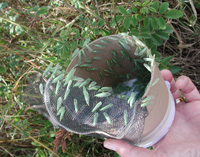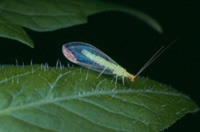Effect of Adult Lacewing Releases in Tomato Field Perimeters on Silverleaf Whitefly Populations and TYLCV Incidence
Project description and objectives:
Tomato Yellow Leaf Curl Virus (TYLCV), vectored by the silverleaf whitefly, (Bemisia tabaci, “B” Biotype) has become one of the top problems for tomato growers in Florida with annual crop and  revenue losses increasing each year. Resistance problems with many currently used pesticides is an increasing concern and with an increase in the acreage of longer season grape tomatoes and vine ripe operations, the critical host free period is shrinking. Lacewings adults and larvae are known to be predators of whiteflies. This project attempted to quantify the impact of releases of pre-fed lacewing adults in tomato field perimeters on populations of the silverleaf whitefly (SWF) both within the production field and on field perimeters. This method has reportedly shown success in cotton and other crops in other locations.
revenue losses increasing each year. Resistance problems with many currently used pesticides is an increasing concern and with an increase in the acreage of longer season grape tomatoes and vine ripe operations, the critical host free period is shrinking. Lacewings adults and larvae are known to be predators of whiteflies. This project attempted to quantify the impact of releases of pre-fed lacewing adults in tomato field perimeters on populations of the silverleaf whitefly (SWF) both within the production field and on field perimeters. This method has reportedly shown success in cotton and other crops in other locations.
Project activities:
Evaluations were initiated on 4 commercial tomato farms consisting of a control block and a lacewing release block on each farm. Lacewing adults were released weekly around the perimeter of each release block for 16 weeks. The lacewings were directed into the weedy areas along the field edges. Yellow sticky traps were placed in fields and field perimeters and examined weekly with whitefly adults counted and recorded. Plants with obvious symptoms of virus were counted twice weekly and the numbers of whitefly adults per plant were determined. Data were collected on weed species within a meter of each sticky trap to estimate the relative abundance of SWF weed hosts at each site.
The specific objectives of this project were: a) to attempt to quantify the benefits of field perimeter releases of lacewing adults on whitefly numbers and TYLCV within fall season tomato production fields under conventional spray programs; b) to gain experience with the use of beneficial insects in commercial tomato production fields, including observing preferred host plants around tomato fields for lacewings and c) to increase visibility of the use and potential benefits of lacewing releases in commercial tomato fields with growers.
Project accomplishments:
The data was variable over time and no consistent trends were discernible. There were no significant differences among trap catches, plants with virus symptoms, or whitefly counts on the  plants. Weeds present around field perimeters were varied (view table of weed observations). Weeds are listed from highest to lowest density at each perimeter trap by block and farm site. The weeds highlighted in yellow are known silverleaf whitefly hosts. While all sites had some weed hosts present, there did not appear to be much difference in numbers. There is a lack of data on weed hosts of TYLCV. This is an area of research that would be beneficial to the overall management picture.
plants. Weeds present around field perimeters were varied (view table of weed observations). Weeds are listed from highest to lowest density at each perimeter trap by block and farm site. The weeds highlighted in yellow are known silverleaf whitefly hosts. While all sites had some weed hosts present, there did not appear to be much difference in numbers. There is a lack of data on weed hosts of TYLCV. This is an area of research that would be beneficial to the overall management picture.
Although no significant affect of releasing lacewing adults was found for SWF numbers or TYLCV incidence, grower knowledge is greater and interest has increased based on the number of questions received about this project. The interest is due in part to the escalating problem with SWF and TYLCV and the limited number of chemical control products and concerns about resistance.
Project leaders:
- Dr. Phyllis Gilreath, Manatee County Extension
- Dr. David Schuster, Entomologist - GCREC
- Alicia Whidden, Hillsborough County Extension